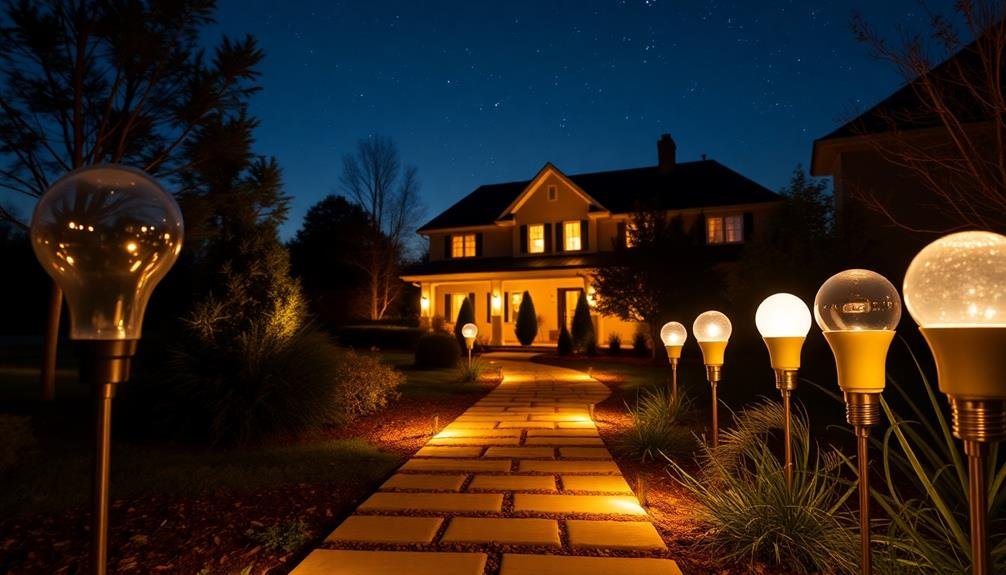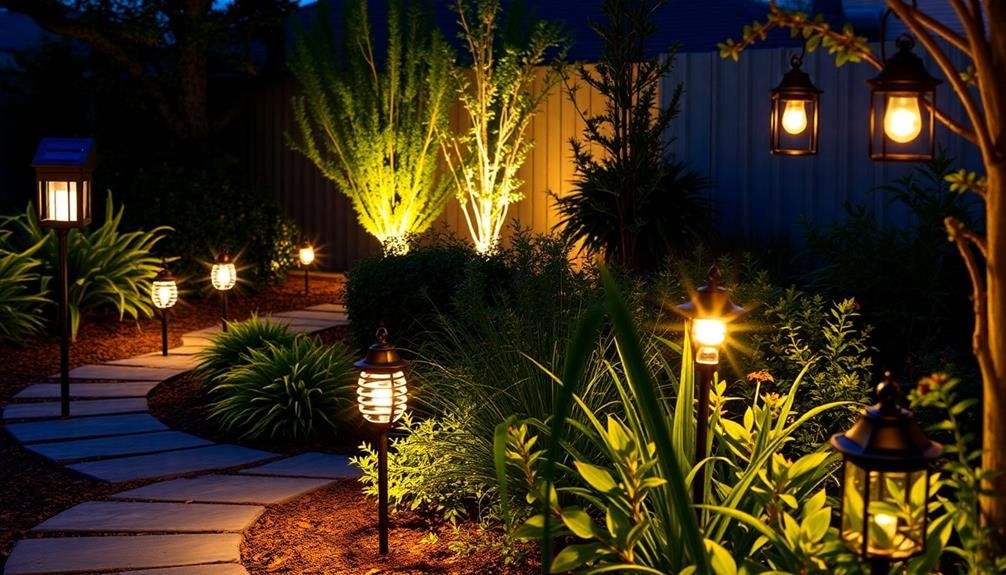To save energy with your outdoor lighting, start by switching to LED bulbs, which use less electricity and last longer. Install motion sensors to activate lights only when needed, particularly near entryways and walkways. Incorporate solar-powered lights for areas that receive ample sunlight, eliminating the need for wiring. Use timers to automate your lighting schedule, ensuring lights are on only during necessary hours. Finally, optimize your fixture placement to maximize illumination while minimizing energy waste. By strategically positioning lights and considering natural light sources, you'll create an efficient outdoor lighting system. These tips will not only reduce your energy bills but also enhance your home's security and curb appeal.
Choose LED Bulbs

LEDs are the gold standard for energy-efficient outdoor lighting. They consume considerably less electricity than traditional incandescent or even CFL bulbs, translating to lower energy bills and a reduced carbon footprint.
When selecting LED bulbs for your outdoor spaces, consider their lumen output rather than wattage. Lumens measure brightness, while watts indicate energy consumption. For example, a 12-watt LED can produce the same light as a 60-watt incandescent.
Look for LED bulbs with a color temperature between 2700K and 3000K for a warm, inviting glow that won't disrupt your neighborhood's ambiance or wildlife. These bulbs also have impressive lifespans, often lasting 25,000 hours or more, reducing replacement frequency and associated costs.
When shopping, choose LED bulbs specifically designed for outdoor use. They're built to withstand temperature fluctuations and moisture exposure. Many outdoor LEDs come with additional features like motion sensors or dusk-to-dawn automation, further enhancing energy savings.
Don't forget to check for ENERGY STAR certification, ensuring the bulbs meet strict efficiency guidelines. By switching to LED outdoor lighting, you'll enjoy long-term savings and contribute to a more sustainable environment.
Install Motion Sensors
Motion sensors are a game-changer for outdoor lighting efficiency. They automatically turn lights on when movement is detected and off when it's not, considerably reducing energy waste. You'll no longer have to worry about forgetting to switch off your outdoor lights or leaving them on all night.
Install motion sensors near entry points, walkways, and driveways for maximum effectiveness. They're particularly useful for security lighting, deterring potential intruders while conserving energy. Most motion sensors have adjustable settings, allowing you to customize the detection range and duration the light stays on.
When selecting motion sensors, opt for weather-resistant models designed for outdoor use. Consider dual-technology sensors that combine passive infrared (PIR) and microwave detection for improved accuracy and fewer false triggers.
You can also find solar-powered motion sensor lights, which are easy to install and don't require electrical wiring.
To further enhance energy savings, pair motion sensors with LED bulbs. This combination provides instant, bright light when needed while minimizing electricity consumption.
Remember to clean the sensor periodically to maintain peak performance and adjust its position if you notice frequent false activations.
Use Solar-Powered Lights

Another excellent option for energy-efficient outdoor lighting is solar-powered lights. These lights harness the sun's energy during the day and illuminate your outdoor spaces at night, eliminating the need for electrical wiring and reducing your energy bills.
You'll find a wide variety of solar lights available, including path lights, spotlights, and decorative string lights.
To maximize the effectiveness of solar-powered lights, place them in areas that receive ample sunlight during the day. Avoid shaded spots or areas obstructed by trees, buildings, or other structures. Clean the solar panels regularly to guarantee peak energy absorption.
Remember that solar lights may not provide as much brightness as traditional electric lights, so you might need to use more fixtures to achieve the desired illumination.
Consider using solar lights for accent lighting, such as highlighting garden features or illuminating walkways. They're also great for areas where running electrical wiring would be difficult or expensive.
While the initial cost of solar lights may be higher than traditional options, you'll save money in the long run through reduced energy consumption and lower maintenance costs. Plus, you'll be contributing to a more sustainable environment by using renewable energy.
Implement Timers
In addition to choosing energy-efficient light sources, implementing timers for your outdoor lighting can greatly reduce energy consumption. Timers allow you to automate when your lights turn on and off, guaranteeing they're only active when needed. You'll save energy and money by not accidentally leaving lights on during daylight hours or throughout the night.
Install timers on your porch lights, landscape lighting, and security fixtures. Many modern timers offer programmable schedules, allowing you to set different on/off times for weekdays and weekends. Some even adjust automatically for seasonal changes in daylight hours.
Consider combining timers with motion sensors for maximum efficiency. This setup guarantees lights activate only when there's movement and turn off after a set period. For areas requiring constant illumination, use astronomical timers that adjust to sunset and sunrise times throughout the year.
Don't forget to regularly check and maintain your timers. Clean any outdoor timer boxes to prevent moisture buildup, and replace batteries in battery-operated units as needed.
Optimize Fixture Placement

While timers control when your lights operate, where you place your fixtures is equally important for energy efficiency. Strategic placement can maximize illumination while minimizing energy consumption.
Start by identifying key areas that require lighting, such as entryways, pathways, and potential safety hazards. Position lights to cover the largest area possible without creating dark spots or overlapping illumination.
For pathways, place fixtures at regular intervals to guarantee even lighting. When lighting larger areas, opt for fewer, higher-mounted fixtures rather than multiple low-level lights. This approach reduces the number of fixtures needed and improves overall coverage.
Consider using adjustable fixtures to direct light precisely where it's needed, avoiding wasteful spillover. For security lighting, angle motion sensors downward to detect people rather than passing cars or animals.
When illuminating architectural features, place lights close to the structure to minimize light pollution and energy waste. Don't forget to account for natural light sources. Positioning fixtures away from streetlights or other ambient light sources can prevent redundancy.
Frequently Asked Questions
How Does Color Temperature Affect Energy Efficiency in Outdoor Lighting?
You'll find that lower color temperatures (warmer light) are generally more energy-efficient for outdoor lighting. They require less power to produce the same brightness as cooler lights. Choose bulbs around 2700K-3000K for ideal energy savings.
Are There Any Weatherproof Considerations for Energy-Efficient Outdoor Lighting Fixtures?
Yes, you'll want to choose outdoor lighting fixtures with weatherproof ratings. Look for IP65 or higher ratings to guarantee they're protected from rain and dust. Sealed fixtures also prevent moisture buildup, which can affect energy efficiency and longevity.
What's the Average Lifespan of Energy-Efficient Outdoor Lighting Systems?
You'll find that energy-efficient outdoor lighting systems typically last 5-15 years. LED fixtures often boast the longest lifespan, reaching up to 50,000 hours. However, factors like usage, weather exposure, and maintenance can affect their longevity.
Can Dimming Features Be Incorporated Into Energy-Saving Outdoor Lighting Setups?
Yes, you can easily incorporate dimming features into energy-saving outdoor lighting. You'll find many options available, from simple dimmers to smart systems. They'll help you adjust brightness, save more energy, and create the perfect ambiance for your outdoor space.
How Do Local Light Pollution Regulations Impact Energy-Efficient Outdoor Lighting Choices?
You'll need to check your local regulations on light pollution. They may limit brightness, directionality, and timing of outdoor lighting. You're often required to use shielded fixtures and warm-colored bulbs to minimize sky glow and glare.
In Summary
You've now got the tools to make your outdoor lighting both efficient and effective. By choosing LED bulbs, installing motion sensors, using solar power, setting timers, and optimizing fixture placement, you'll save energy and money. These simple changes won't just reduce your carbon footprint; they'll also enhance your home's security and ambiance. So don't wait—start implementing these tips today and enjoy the benefits of smarter outdoor lighting.





Leave a Reply